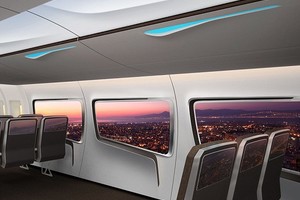
Does this design solve the plane boarding nightmare? Airbus patents new style of cabin in which passengers enter through double doors in widened middle section.
Boarding a plane can prove to be one of the more frustrating aspects of air travel.

Ipek believes that not only will his design reduce queuing time, but passengers will also find it much easier to locate their seats
From scrambling for position in the queue to squeezing past passengers blocking the aisles once on board, it can often prove to be a stressful start to the holiday.
However one German designer believes he has a solution that could bring to an end this particular peril of flying - and it's as simple as widening the aisle where the passengers are boarding.
Ugur Ipek, 44, who has designed interiors for aeroplanes as well as major car companies such as Mercedes-Benz, BMW and Volkswagen, believes his CIGAR design is the future of air travel.
The two main aspects of his work involve moving the boarding doors to the centre of the plane, where the aisle will be wider, before it narrows as it runs down to each end of the plane.
Speaking to MailOnline Travel, Ipek said: 'I thought, "how can we increase the flow when boarding a plane and make their less bustle and less queuing," and the answer is to board in the middle into a wide aisle.
'With a large, welcoming central point, this would solve that problem, and also people would find it much easier to locate their seats.'
'In planes nowadays, as soon as someone stops to load a bag, it causes a chain, and the backlog takes time to shift.'

The German's design resembles a cigar known as the 'perfecto,' that is fat in the middle and thin at the ends

Ipek believes his double-door entry into a wider aisle will reduce a backlog of passengers we currently see
The design replicates the shape of a 'perfecto' cigar, which is fatter in the middle with smaller ends. Ipek believes that, dependent on how far the plane can be widened, there is potential for a welcome area, a bar, or even a casino in the middle of the plane.
'The design was liked so much by Airbus that it put in a patent for it in 2006, but I've not been able to talk about it until now,' added Hamburg-based Ipek.
'It's true you would have to make planes wider, but from the feedback I have got from engineers, this is favourable as it would be the area over the wings anyway and central.'
Ipek has also put forward designs for the windows in the cabin, with three large panels for viewing located between the two doors.
So when will this design hit the market?
'Airbus have the design and are looking into how this can be developed, but I'm not aware of when this might actually happen,' he said


